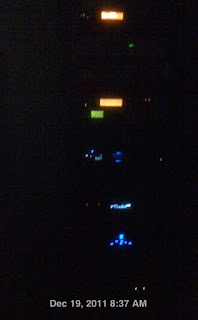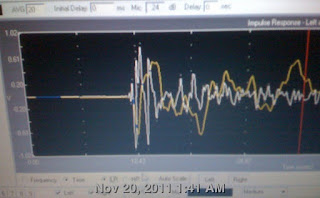I originally bought the Oppo BDP-95 player as my new central video player, to play Blu Ray and other discs in the Kitchen, from which digital AV signals are set to other rooms. The fact that it has a cooling fan will not be a problem there, because the kitchen (my AV production center) is full of equipment having running fans, not to mention refrigerator. I might have done just as well with the BDP-93 or some other player, but I just wanted the hottest new model.
When it arrived, I decided to hook it up to my main living room audio system just because it has a high end audio output section, including current best DAC chips and balanced output. I was immediately hooked, and shortly decided to use the Lavry AD10 to digitize balanced analog output from SACD's and DVD-Audio discs which don't permit you to access the maximum resolution 24 bit digital audio directly.
But it has bugged me all along that the Oppo, which not as noisy as some old DVD players, is not exactly the quietest either. Notably, the Oppo has a fan, which is audible, though just barely, from listening position. I figured, however, that the mechanism itself was fairly quiet, perhaps quieter than the Denon 5900 I had been using previously.
I finally got around to comparing the mechanical noise levels of both players when playing one of my favorite SACD's, Santana's Supernatural. And it turned out that the Denon 5900 makes way less noise, and the difference is very noticeable when playing discs. The fan is actually the smaller part of it.
When playing this disc, the Oppo has a characteristic woosh sound, as you might expect something spinning at high speed. It is actually a very pleasant sound, but it is just too loud for good hifi. I tried using the RTA application of my iPhone to measure this noise, but that did not turn out to be a very good tool for measuring, and as I was trying to measure the noise level, the heater and refrigerator kept deciding to turn on and off, making it difficult to make the measurements. The noise produced by refrigerator pretty much masks the noise from the player, at around 41dBA everywhere in the room. When the refrigerator shut off, the Oppo seems to measure about 39dBA from about 6 inches. When the Oppo was turned off, noise level dropped to 37dBA. This sounds like a small difference, but from 6 inches the Oppo is clearly and plainly audible above background noise. I decided to mainly rely on subjective noise level assessments, the SPL meter at hand not being particularly informative.
With the Denon hooked up and playing the same disc, the chassis noise level measured 37dBA regardless of whether player was on or off. It was obviously much quieter. If you listen carefully, the Denon noise is more complex and mechanical sounding, with a tonal whine and faint clicking. But it all sounds about 12dB or so quieter than the Oppo, and that makes a huge difference. From my listening position, it is much harderto tell whether Denon is running at all, except when it changes tracks and some motor seems to change speeds up and back down.
Actually listening to Supernatural was a revelation. I had been listening to this disc for a couple weeks on the Oppo, so I was feeling like I've heard it all, but I hadn't. I first noticed an interesting kind of coherency: purpose. You could almost sense the two percussionists on the two sides of the room. I wasn't just hearing the instruments, I had the sense that the percussion instruments were being played by different people, and I could sense the two different people, and what feelings they were trying to communicate. In short, the music seemed to have purpose. It wasn't just "there" it was being created by real people, to communicate. Another description I thought of at the time: integrity.
Later I noticed more typical transparency, I was hearing very low level counterpoint I hadn't noticed before.
Overall, I felt the Denon provided a subtle but valuable improvement in transparency. But everything I heard could be explained just by the chassis noise level, which is way higher than the electrical noise levels in the output signals from the players.
Consider that a typical peak playback level for me is around 95 dB (and that's generous). Then an ambient noise level of 39dBA is only 56dB down, enough to obscure musical details, with the music rising out of the fog of whirring chassis noise.
As far as the electrical output, the Denon is spec'd at 120dB S/N whereas the Oppo is probably at least 6dB better than that (some claim around 130dB). But this is all moot if the chassis noise is only 56dB down.
What's worse, both players are in front of the room, in between the speakers but just slightly further back. That means that any chassis noise cannot be separated from the musical image by the brain.
I had also been thinking of moving the Oppo back to highly absorptive corner in back of the room to make the noise lower and get it out of the audio image. That is what I had been doing with the Denon, but I often found it very inconvenient. Junk also tends to accumulate in that part of the room, and quite often the player was not accessible. Then I discovered how convenient it is to have my disc player in front of the room along with my other equipment. It's always accessible, and much more convenient to change discs without getting on knees, etc., as well as operating controls and getting feedback on controls.
Although the Denon isn't silent either, I think it's just quiet enough to keep at the convenient front-of-the-room position, at least for now. So then I have both convenience and top quality performance. At some future time, when (and if) I'm ever more organized, I could put my disc player in back of the room again, and then the Oppo might well be a contender again.
The sound of the Denon was possibly slightly brighter than the Oppo. This could also be explained as the Oppo transport noise masking high frequency details.
While it is a little old, there is nothing inferior about the audio design and performance of the Denon 5900. Like the Oppo, it has a separate analog power supply for the audio section. It uses Burr Brown's best DAC's from 2004, essentially identical to the ones in the Denon 5910 which was still being sold as new in 2010. The ESS 32 bit DAC's used in the Oppo may be slightly better, but I suspect it would be rather hard to hear the difference, assuming the players were not contributing their own mechanical noise to the room.
The Denon output is not balanced, but I run the composite video output through an isolation transformer before connecting to the TV, and composite video is OK for watching the menus and pictures on DVD-Audio discs. The isolation transformer makes it less necessary to have balanced audio.
One problem is Denon can't play the high rez audio Blu discs in the recent Pink Floyd immersion sets.














